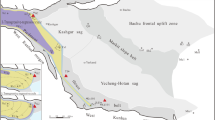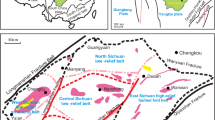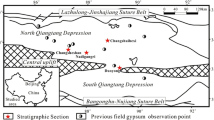Abstract
The upper member of the Xiaganchaigou Formation in the Yingxi Area of the Southwestern Qaidam Basin is a set of evaporite-bearing lacustrine series. In this study, petrographic analyses of rock thin sections, cores, drillings, logging as well as geochemistry were used to study the characteristics of the sedimentary cycles of the series. Concurrently, this study adopts a transgressive–regressive (T–R) cycle sequence theory, based on lithology, logging curves, the stacking pattern of the subsequences, and unconformity and seismic reflection terminal relations. This approach uses evaporites as the primary marker layer for identifying the initial lake flood surface and dividing the sequence of the evaporite-bearing series in the upper member of the Xiaganchaigou Formation. Results show a zonal distribution of evaporites transitioning laterally from the center to the margin of the basin to mixed carbonate rocks and then to clastic rocks. Vertically, there are two third-order sedimentary cycles and six fourth-order sedimentary cycles. Five types of evaporite lithofacies combinations were identified. Evaporites were formed by evaporative crystallization at a particular depth beneath lake water during a lacustrine regression during an arid paleo-climate and rapid subsidence of the basin basement. It has been established based on the asymmetric sedimentary cycle development model that during the lacustrine transgression stage, the mixed carbonate rocks were transformed into mudstone upward, and during the lacustrine regression stage, the mixed carbonate rocks transformed into gypsum rocks, glauberite, and halite, upward, while a delta and reef flat limestones developed at the edge of the basin. There is a one-to-one correspondence between the T–R cycle sequence division and the sedimentary cycle division.









Similar content being viewed by others
References
Cao Z, Wei Z, Lin C, Zheng X, Ma X (2014) The kinetics of oil generation in a saline basin: a case study of the source rock of tertiary in Zha-haquan depression, Qaidam Basin, China [J]. Petrol Sci Technol 32(21):2648–2657
Chen QL (2007) Favorable condition and exploration prospecting of lithologic hydrocarbon reservoir in large-scale saline basin—Case study on the Eogene in the southwest of Qaidam Basin [J]. Lith Res 19(1):46–51 (in Chinese)
Chen ZH, Osadetz KG, Li MW (2005) Spatial characteristics of middle devonian oil and non-associated gases in the Rainbow area, Northwest Alberta [J]. Mar Pet Geol 22(3):391–401
Cross TA (1988) Controls on coal distribution in transgressive-regressive cycles, upper Cretaceous, Western Interior, USA [M]. In: Wilgus CK (ed) Sea-Level Changes: an Integerated Approach. Springer, Londone
Fu ST, Zhang DW, Xue JQ, Zhang XB (2013) Exploration potential and geological conditions of tight oil in the Qaidam Basin [J]. Acta Sedimentol Sin 31(4):672–682
Galloway WE (1989) Genetic stratigraphic sequences in basin analysis (I): architecture and genesis of flooding-surface bounded depositional units [J]. AAPG Bull 73(2):125–142
Gong XM, ZENG JH (2003) Impact of Paleogene evaporates on hydrocarbon accumulation in deep Bonan Sub-sag. Jiyang Depress Pet Explor Dev 30(5):24–27
Guo P, Liu C, Wang P, Wang K, Yuan H, Li B (2019) Geochemical behavior of rare elements in Paleogene saline lake sediments of the Qaidam Basin, NE Tibetan Plateaup [J]. Carbon Evap. https://doi.org/10.1007/s13146-017-0394-x
Huang CG, Yuan XY, Song CH, Yuan JY, Ni XL, Ma XM, Zhang SM (2018) Characteristics, origin, and role of salt minerals in the process of hydrocarbon accumulation in the saline lacustrine basin of the Yingxi Area, Qaidam, China [J]. Carbon Evap. https://doi.org/10.1007/s13146-017-0350-9
Huang CJ, Chen KY, Yang XH (2002) Characteristics of sequence stratigraphy in the saline lake basin [J]. Oil Gas Geol 23(2):134–138 (in Chinese)
Hu SY, Shi SY, Wang TS, Liu W, Bai B, Xu AN, Tu JQ, Huang SP, Jiang H (2016) Effect of gypsum-salt environment on hydrocarbon generation, reservoir-forming and hydrocarbon accumulation in carbonate strata [J]. China Pet Explor 21(2):20–27 (in Chinese)
Halbouty MT (2003) Giant oil and gas fields of the decade, 1990–1999 [M]. Tuls 12:23–56
Jia CZ, Zhao WZ, Wei GQ, Liu DL, Zhang JF (2003) Salt structures and exploration of oil and gas [J]. Pet Explor Dev 30(2):17–19
Jiang QC, Ma YS, Shen YC, Guo RT, Gao XQ, Liu B, Cui Jun WuKY (2019) High-frequency redox variations of the Eocene cyclic lacustrine sediments in the Yingxi area, western Qaidam Basin, China [J]. J Asian Earth Sci 174(2019):135–151
Jin Q (2003) Geochemistry characteristics of trace elements in evaporates of the Tertiary [J]. J China Univ Pet Nat. Sci. 27(2):1–5 (in Chinese)
Johnson JG, Klapper G, Sandberg CA (1985) Devonian eustatic fluctuations in Euramerica. Geol Soc Am Bull 96(5):567–587
Liu CL, Jiao PC, Wang EL, Chen YZ (2007) Sedimentation of glauberites and its effect on potash deposits formation in Lop Nur salt lake, Xinjiang, Chinam [J]. Miner Depos 26(3):322–329 (in Chinese)
Liu CL, Ma LC, Jiao PC, Sun XH, Chen YZ (2010a) Chemical sedimentary sequence of Lop Nur salt lake in Xinjiang and its controlling factors [J]. Miner Depos 29(4):625–630 (in Chinese)
Liu Q, Zhang LY, Song GQ, Song CY, Wang R (2009) Application of occurrences of gypsum minerals in saline lacustrine facies analysis and source rocks organic geochemistry evaluation: a case study of Wendong subdepression [J]. Geol J China Univ 15(3):371–379 (in Chinese)
Liu SG, Zhang ZJ, Huang WM, Wang GZ, Sun W, Xu GS, Yuan HF, Zhang CJ, Deng B (2010b) Formation and destruction processes of upper Sinian oil-gas pools in the Dingshan-Lintanchang structural belt southeast Sichuan Basin China. Pet Sci 7(3):289–301
Matano F, Barbieri M, Di Nocera S et al (2005) Stratigraphy and strontium geochemistry of Messinian evaporite-bearing successions of the southern apennines foredeep, Italy: implication for the Mediterranean “salinity crisis” and regional palaeogeography [J]. Palaeogeogr Palaeoclimatol Palaeoecol 217(1):84–114
Ma XM, Huang CG, Shi YJ (2019) Oil and gas enrichment patterns and major controlling factors for stable and high production of tight lacustrine carbonate rocks, a case study of Yingxi area in Qaidam Basin, West China [J]. Carbon Evap. https://doi.org/10.1007/s13146-019-00529-9
Philipp SL (2008) Geometry and formation of gypsum veins in mudstones at Watchet Somerset SW England. Geo Mag 145(6):831–844
Shi YJ, Xu L, Xing LT, Wang JG (2020) Geochemical characteristics of crude oil in the continental saline lake basin: a case study of the upper part of the lower Ganchaigou formation in Yingxi Qaidam Basin China [J]. Petrol Sci Technol 38(3):232–239
Sui LW, Fang SH, Sun YH, Yang CY, Meng QX, Gui LL, Chen Y (2014) The tectonic evolution and accumulation controlling characteristics of Shizigou-Yingdong structural belt of western Qaidam Basin [J]. Geosci Front 21(1):261–270 (in Chinese)
Ulisses TM, Carry DK (1996) Development of sediment over pressure and its effective thermal maturation: application to the Gulf of Mexico Basin [J]. AAPG 80(9):1367–1396
Vail PR, Mitchum RM Jr, Thompsons S (1977) Global-cycles of relative changes of sea level [J]. AAPG Memoir 83(1977):469–472
Wu H, Zhao MJ, Lu XS, Zhuo QG (2016) Research progress of hydrocarbon accumulation mechanism controlled by salt [J]. Geol Sci Technol Inf 35(03):77–86 (in Chinese)
Wang J, Xi P, Liu ZC, Wang YJ (1996) Cenozoic climate and topographical changes in the western Qaidam Basin[J]. Geol Rev 42(2):166–173 (in Chinese)
Wang L, Jin Q, Lin LM, Liu YC, Zhang BM (2009) Characteristics of quality tertiary source rocks in west Qaidam Basin [J]. Nat Gas Ind 29(2):23–26 (in Chinese)
Wang JG, Zhang DW, Yang SY, Li X, Shi YJ, Cui J, Zhang P, Wang YL, Yi DH, Chang HY (2019a) Sedimentary characteristics and genesis of the salt lake with the upper member of the lower Ganchaigou formation from Yingxi sag, Qaidam basin [J]. Mar Pet Geol 111(2020):135–155
Wang YQ, Zhanguo L, Song GY, Zhang YS, Zhu C, Li SM, Wang P, Tang PC (2019b) Genesis of lacustrine carbonate breccia and its significance for hydrocarbon exploration in Yingxi region, Qaidam Basin, NW China[J]. Pet Explor Dev 46(1):104–112
Xia QS, Huang CG, Cui J, Li YF (2019) Reservoir space type and storage capacity of Oligocene lacustrine carbonate in the Yingxi area of Western Qaidam Basin, China [J]. Carbon Evap. https://doi.org/10.1007/s13146-018-0476-4
Xu SL, Lü XX, Yang MH, Ma YJ, Liu LF (2004) Controlling effect of gypsum and salt rocks on abnormally high pressure in Kuche Depression [J]. J Nat sci 19(4):5–8 (in Chinese)
Yi DH, Wang JG, Shi YJ, Sun JX, Ma XM, Wang P, Li YL (2017) Evolution characteristic of gypsum-salt rocks of the upper member of Oligocene Lower Ganchaigou Fm in the Shizigou area, western Qaidam Basin [J]. Nat Gas Ind 37(5):1–9 (in Chinese)
Yang QT (1989) The origin and sedimentary environment analysis of glauberite [J]. Acta Sedimentol Sin 7(3):137–141 (in Chinese)
Zeng LB, Zhou TW, Lü XX (2004) Influence of tectonic compression on the abnormal formation pressure in the Kuqa depression [J]. Geol Rev 50(5):471–475 (in Chinese)
Zhang CC, Zhang S, Wei W, Wu CD, Liang JP, Niu W, Du JX, Fu XL, Cui KN, Wang C, Wang H (2014) Sedimentary filling and sequence structure dominated by T-R cycles of the Nenjiang formation in the Songliao Basin[J]. Sci Sinica Terrae 44(12):2618–2636 (in Chinese)
Zhang H, Chen G, Zhu YS, Huang CG, Ni XL, Ma XM, Zhang P (2018) Discovery of rare hydrothermal alterations of Oligocene dolomite reservoirs in the Yingxi area, Qaidam, West China [J]. Carbon Evap. https://doi.org/10.1007/s13146-017-0353-6
Zhao ZY, Zhou YQ, Ma XM, Ji GS (2007) The impact of saline deposit upon the hydrocarbon accumulation in petroliferous basin [J]. Oil Gas Geol 28(2):299–308 (in Chinese)
Author information
Authors and Affiliations
Corresponding author
Additional information
Publisher's Note
Springer Nature remains neutral with regard to jurisdictional claims in published maps and institutional affiliations.
Rights and permissions
About this article
Cite this article
Xu, B., Li, J., Wu, Z. et al. Sedimentary cycles of evaporites and their application in sequence division in the upper member of the Xiaganchaigou Formation in Yingxi Area, Southwestern Qaidam Basin, China. Carbonates Evaporites 35, 66 (2020). https://doi.org/10.1007/s13146-020-00603-7
Accepted:
Published:
DOI: https://doi.org/10.1007/s13146-020-00603-7




